-

人教版新目标初中英语八年级下册Have you ever been to an amusement park教案
(1)Have you ever been to …? Yes, I have. / Yes, I have ever been to …No, I haven’t. / No, I have never been to …(2)When did you go there? I went there last year. (3)I have never been to a water park. Neither have I. I have ever been to an amusement park. So have I. (4)How long have you been studying English? I’ve been studying English since nine o’clock. I’ve been studying English since I came back home. I’ve been studying English for five hours. (5)What’s that? It’s an amusement park in Japan. I’ve never been to an amusement park like it before. It’s fun to learn another language. Let’s go tonight. Isn’t this great?space museum, amusement park, water park, South America, Peru, Holland, European culture, tour guide, flight attendant, musical instrument, more than, be from, get to, take lessons, neither, discover, graduate, change

人教版新目标初中英语八年级下册He said I was hard-working教案2篇
This activity introduces some new vocabulary and provide oral practice using the target language.Task 1 . Ask four students to stand in front of the class, and the teacher asks them the following questions as a reporter.1.What are you going to do when you grow up?2.What are you going to do next week?3.What are going to do after school?The students will give different answers, then ask a good student to report what they said.I am going to e a doctor.What did she say?----------She said she was going to be a doctor.I am going to have a party on Friday night.What did he say?-------He said he was going to have a party on Friday night.I am going to do my homework.What did she say ?------ She said she was going to do her homework.I am going home after school.What did she say?-----She said she was going home after school.Say In this unit we are going to learn to use words like to report what someone said.Task 2. Read the instructions. Then ask a student to read the four questions. And write the words on the Bb. Explain what soap opera is.Task 3. Ask the students to Look at the pictures, point out the TV screens in the picture. Ask one girl to read what Marcia said.What did Marcia say? She said She said she was having a surprise party for Lana on Friday night. Repeat the other pictures in the same way.Activity3. Listen and number the pictures in activity 1a.

人教版新目标初中英语八年级下册How long have you been collecting shells教案2篇
Step Ⅱ Show the new words on the screen and teach the new words. Read the new words to students and ask them to repeat.Step Ⅲ 3aThis activity introduces new vocabulary and provides reading practice using the target language.In this activity first look at the four pictures.T: What can you see in the pictures?Ss: Four snow globes.T: Right. There are four snow globes in the pictures. And what are they?Ss: They are a monster, two polar bears, two penguins and a birthday cake.Write these words on the blackboard: snow globe; monster; polar bear; penguin and birthday cake. Read them to the class and ask students to repeat each one. Make sure students understand each word.Use a computer to show the E-mail message on the screen and read the message to students.Get students to read the e-mail on their own, and then draw lines connecting each snow globe and its description.Correct the answers.AnswersA line should connect each snow globe picture with the words that describe it in the letter.Step Ⅳ 3bThis activity provides writing practice using the target language.First review Activity 2a on Page 47.Then ask students to complete the message according to Activity 2a.Some partial sentences are given to students. Write about one person's collection.When students work, walk around the room checking the progress and offering help as needed.When they finish, ask some students to read their messages to the class.

人教版新目标初中英语八年级下册What were you doing when the UFO arrived教案2篇
(一).知识方面: 1.培养学生能运用过去进行时来描述、谈论过去某个时间正在发生的事情或动作的意识和能力,能就过去某个时间正在发生的动作做出正确的描述。 2.培养学生的想象力和角色扮演的合作能力。 3.培养学生讲述过去发生的事情经过的能力。能正确运用一般过去时来讲述故事。 (二).技能方面: 1.本单元的语言目标是Talk about past events and tell a story(谈论过去的时间和讲述一个故事),围绕这一目标,要涉及句型: What were you doing when the UFO arrived? ----I was sitting in the barber’s chair. The barber was cutting my hair. 因此必须学习standing、studying、cleaning、sleeping、cooking、making、eating、cutting、等表示地点的词,以便为上述句型提供语言材料。2.学习过去进行时的有关知识。Was/were+现在分词,是该时态的表达式。 3.在学习过程中,要区分The boy was walking down the street when the UFO landed.和While the boy was walking down the street, the UFO landed.这两种由when和while引导的状语从句的句型结构。注意它们的不同。

人教版新目标初中英语八年级下册Why don’t you get her a scarf教案
教师带领学生复习有关描述宠物的词汇,采用教师提问学生回答的方进行。如:T:What animals do you think would be good pets?What animals do you think would be bad pets?What do you think are good animals for a six-year-old child?然后学生进行 pairwork 练习。Task two: 师生互动,学习探究 1、播放3a部分的录音,引导学生一边听录音,一边跟读。2、通过听录音学生回答以下问题:Why do you think pot-bellied pigs are popular?What are the advantages and disadvantages of keeping such a pet?教师对学生的回答进行及时点评。3.学习范文,学习重点短语,为下步的模仿写作提供语言素材。T :1. )Have you ever kept a pig as a pet?Do you like pigs? St.:No.…Why don’t you like to keep a pig? St: No.They’re too dirty and lazy(Do you know in some foreign countries like Hollyland, Australia,pigs are the most popular pet.there’s a kind of pig.(图)it has an interesting name? it ‘s called a pot-bellied pig.) Now,let’s learn an article about this kind of interesting pet.2.)play the tapeSt.:Listen and repeat3.)show some Qs on computer(本子St.: read silently,then answerthe Qs(本子)4.)Ask ss. Close book and retell this passage.(what is a pot-bellied pig? Is it a good or bad pet? ) St.: retell it to each other“A pot –bellied pig is a popular pet now…”5.read the article together.St.:.practice reading

人教版新目标初中英语八年级下册Would you mind turning down the music教案
Step 4. Group work (4)1. Ask a pair of students to read the dialogue. Say, This activity provides speaking, listening and writing practice using the target language.2. Ask students to complete the work in groups.3. Check the answers with the whole class. 4. Explain some of the language points. Step 5. Word review (Self check 1)1. Ask students to read the words and the phrases given. 2. Fill in the blanks with proper forms of these words to complete the sentences. 3. Check the answers with the whole class. Homework:Do activity 2 on page 57 after class. Period 6Teaching aims: 1. Teach vocabulary words and the useful expressions. 2. Enable the students to learn etiquette in different culture. 3. Help the students learn how to behave politely in public places and in daily life. Teaching procedures:Step 1. RevisionHelp students to review the function of making requests through a free talk. Then lead them to the topic of etiquette. Explain the meaning of etiquette. Or, ask students to look it up in the dictionary. Step 2. Pre-reading (Section 1)1. Ask students to read the picture and make a list with their partner about how many rules of etiquette can be seen being broken.

人教版新目标初中英语九年级下册By the time I got outside, the bus had already left教案
Ⅰ. Teaching Aims and Demands1. Knowledge Objects(1) Key Vocabularyoversleep(2) Target LanguageWhat happened?I overslept. And by the time I got up, my brother had already gotten in the shower.2. Ability Objects(1) Teach the students to use the new words.(2) Train the students to narrate past events with the Past Perfect Tense.(3) Train the students' listening and speaking skills with the target language.3. Moral ObjectIt’s a good habit to go to bed early in the evening and get up early in the morning. So you’ll never be in a hurry in the morning.Ⅱ. Teaching Key Points1. Key Vocabularyoversleep2. Target LanguageNarrate past events with the Past Perfect TenseⅢ. Teaching Difficult Points1. Train the students to narrate past events with the Past Perfect Tense.2. Train the students to understand the target language in spoken conversation.Ⅳ. Teaching Methods1. Thinking of examples from the students' real lives.2. Making sentences by looking at the pictures.Ⅴ. Teaching AidA tape recorderⅥ. Teaching ProceduresStep I Revision1. Revise the language points in Unit 8.Ask some questions like this: What volunteer work would you like to do?Help the students to answer, I’d like to…/I love to…/I hope to2. Practice the dialogue in Activity 3c on page 62 again. Get students to role play the similar dialogues with the following.

人教版新目标初中英语九年级下册Rainy days make me sad教案
1. 教材分析本单元以how do things affect you?为话题, 从颜色、天气、音乐、广告、产品等方面谈论了外界事物如何影响人的心情。要求学生掌握表达某物或某事给人带来的感觉、看法或影响等。共设计了四个部分的内容:Section A 该部分有4个模块:第一模块围绕Which restaurant would you like to go to?这一话题展开思维(1a)、听力(1b)、口语(1c)训练;第二模块围绕How does music affect you? 进行听力(2a-2b)、口语训练(2c);第三模块继续围绕how do colors in the restaurant affect you这一话题展开训练,训练形式为阅读和问题体验(3a)和小组活动(3b);第四模块仍就How do things affect you这一话题以调查的形式展开讨论。Section B该部分有4个模块:第一模块围绕产品广告对人们的影响这一话题以“配对”(1a)与“列举”(1b)两种形式展开训练;第二模块继续围绕How do things affect you? 进行听力(2a-2b)、口语对话训练(2c);第三模块围绕“Advertising”这一话题展开阅读(3a-3b)和写作(3c)训练;第四模块围绕How posters affect you这一话题以口语训练形式展开小组活动。

人教版新目标初中英语九年级下册Could you please tell me where the restrooms are教案
Step Ⅰ RevisionCheck homework. Ask a few students to read the article in 3a.Then ask a few students to read their guides.Step Ⅱ Part 1Look at the words in the box. Ask a student to read them. Make sure the students understand the meaning of the words. You are to fill in the blanks with the words. In some cases, students may need to use another form of the word, for example adjusting for tense or subject/ verb agreement.Ask students to fill in the blanks on their own.Check the answers. Step ⅢPart 2Go through the instructions with the class.Look at the example with the students.Ask students what the answer would be.Ask a student to read the question and answer it.Excuse me, could you tell me where the bank is, please?The bank is across the street from the shopping malt.Get students to complete the work in pairs.Check the answers. Ask a few students to read their questions.Step Ⅳ Just for Fun!Ask all the students to read the conversation. Ask: What is funny about this cartoon? Help students to explain. A Martian is a person from the planet Mars.There is no such thing as Martian food on Earth, and the clerk looks silly because he is trying to think of where there is a Martian restaurant.Invite some pairs of students to present this conversation to the rest of the class.Step Ⅴ Summary and HomeworkIn this class, we’ve done much writing practice using the key vocabulary words and the target language presented in this unit. After class, please finish the questions in 2 in your exercise books. Then finish the exercises on pages 47~48 of the workbook as well.The Seventh Period Ⅰ Teaching Aims and Demands1. Knowledge Objects(1) Key Vocabularyimage, adventure, jealousy, hero, crime, journey, brave, no longer, show interest in, take it easy, become interested in, plain looks(2)Text:Grown-ups like cartoons, too.2. Ability Objects(1) Fast-reading to get a general idea of the text.(2) Careful-reading to get the detailed information in the text.

人教版新目标初中英语九年级下册We’re trying to save the manatees教案2篇
本单元主要围绕着有关濒临灭绝的动物这一话题,学习了应该怎样保护我们的环境,以及就某一问题展开辩论。目标提示语言目标能够运用所学知识,就某一问题展开辩论。认知目标1、复习一些语法:现在进行时、一般现在时、用used to 表示一般过去时、现在完成时、一般过去时的被动语态。2、学会表达同意和不同意。3、学会以下基本句型:We’re trying to save the manatees.Manatees eat about 100 pounds of food a day.There used to be a lot of manatees.In 1972,it was discovered that they were endangered.Some of the swamps have become polluted.情感目标了解一些濒临灭绝的动物的生活习性和濒临灭绝的原因,教育学生应该如何保护环境。教学提示充分利用多媒体等教学设备,创设与本课话题相关的情境,如各种不同种类的动物、动物园以及有关环境的画画等等。围绕着本单元的教学目标,设计一些贴近学生实际的教学任务,如让学生谈论自己最喜欢的动物,如何拯救濒危动物,如何保护环境等等。让学生根据所学知识,就动物园是否对动物有利以及其他的话题进行辩论。
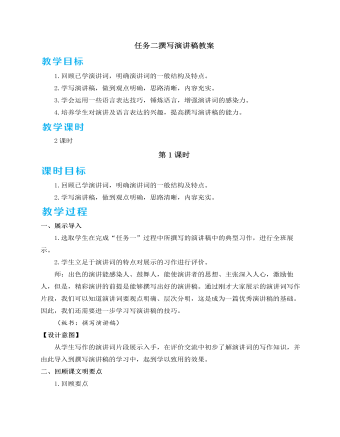
人教部编版语文八年级下册任务二撰写演讲稿教案
[乙]爱是人世间最完美的一种情感,爱就像一缕冬日里的阳光,能让饥寒交迫的人感到温暖;爱就像一泓沙漠中的清泉,能使濒临绝境的人看到希望;爱就像一盏黑暗中的路灯,能让迷惘的人找到方向。我们要让爱永驻心中,哪怕只是对父母的一句“我爱你们”、对朋友的一句“加油”、对摔倒老人的一次伸手。多一份行动,多一份传递,多一种信念,尽自己的微薄之力去帮助他人,回报社会,让爱的种子飞得更远更广,永远地扎根于人们的心中!(生交流讨论)预设 乙结尾运用了比喻、排比等修辞手法,语言更加生动,富于表现力,尤其是排比句的运用,使得句式整齐、有气势,情感表达有感染力。另外,结尾段不断重申观点,也起到了加深听众印象的效果。师:除了运用修辞手法之外,根据演讲稿的特点,我们还可以从哪些方面锤炼语言来增强演讲的表达效果呢?(生结合演讲稿的特点,讨论交流)预设 (1)运用一些口语、大众化的语言,拉近与听众的距离。(2)多用短句,少用结构复杂的长句,使语意清晰,简短易懂。

部编版语文八年级下册《综合性学习:古诗苑漫步》教案
【目标导航】1.主动学习欣赏、演唱古诗词,在反复吟诵中进一步体会中华诗词文化的灿烂辉煌;2.漫步古诗苑,领略多姿多彩的创作风格,了解明星璀璨的大家名人,浏览醒世鉴人的名篇佳句,体会博大精深的思想内容,感知美妙绝伦的艺术特色;3.激励参与意识和创新精神,能借助诗歌抒发真情实感,濡染心灵,陶冶性情,培养文学纯正趣味,提高参与者的文学综合素养。【课时安排】1课时自由组成小组,搜集相关资料,通过多种手段如多媒体,学生绘画,音乐等课程资源,为学生创设优美的教学情境。【新课导入】中国是一个诗的国度,中华诗词是民族文化的宝典,是一朵瑰丽的文学奇葩。今天,让我们就漫步在这个色彩缤纷的世界,在鸟语花香中,品味古人的闲情逸致,在诗情画意中,学习他们的旷达胸襟。
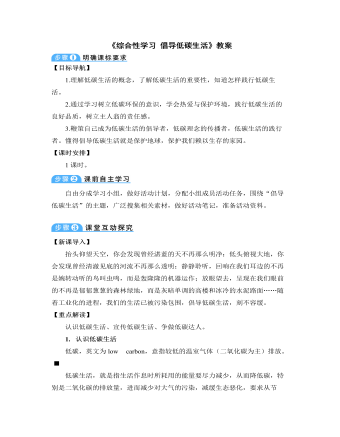
部编版语文八年级下册《综合性学习:倡导低碳生活》教案
【新课导入】抬头仰望天空,你会发现曾经湛蓝的天不再那么明净;低头俯视大地,你会发现曾经清澈见底的河流不再那么透明;静静聆听,回响在我们耳边的不再是婉转动听的鸟叫虫鸣,而是轰隆隆的机器运作;放眼望去,呈现在我们眼前的不再是郁郁葱葱的森林绿地,而是灰暗单调的高楼和冰冷的水泥路面……随着工业化的进程,我们的生活已被污染包围,倡导低碳生活,刻不容缓。【重点解读】认识低碳生活、宣传低碳生活、争做低碳达人。1. 认识低碳生活低碳,英文为low carbon,意指较低的温室气体(二氧化碳为主)排放。低碳生活,就是指生活作息时所耗用的能量要尽力减少,从而降低碳,特别是二氧化碳的排放量,进而减少对大气的污染,减缓生态恶化,要求从节水、节电、节气和回收四个环节来改变生活细节。
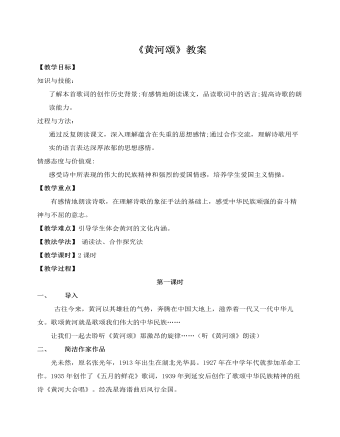
部编版语文七年级下册《黄河颂》教案
六、讨论、探究:1、“黄河的精神”是什么?从本文的哪些词句中可以体会黄河的这种精神?中华民族伟大坚强的精神 2、作者借歌颂黄河表达了怎样的思想感情?作者借歌颂黄河来歌颂中华民族的灿烂文化,歌颂中华民族的伟大精神,歌颂中华儿女的勤劳勇敢、伟大坚强,从而激发整个民族以英勇的气概和坚强的决心来保卫黄河,保卫中国。 3、如何理解黄河是“摇篮”,是“屏障”?把黄河比喻为“中华民族的摇篮”是因为黄河是中华民族的发祥地,黄河哺育、滋养了世代炎黄子孙。把黄河比喻为“民族的屏障”,侧重于黄河对中华民族的保卫作用而言。黄河天险在地理上可作为军事屏障,黄河伟大坚强的精神,更足以成为民族精神上的城防。重点揭谜这是一个比喻句,把黄河比喻为一个巨人,黄河主流是巨人的躯干,黄河流域中的无数条支流就是“巨人”身上千万条“铁的臂膀”。它体现了气势磅礴、勇不可挡的气度和力量,正足以激发民族的精神和信念。
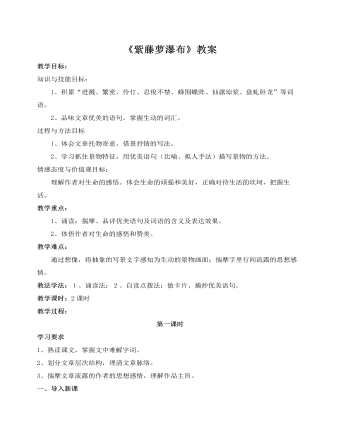
部编版语文七年级下册《紫藤萝瀑布》教案
学习要求1、熟读课文,掌握文中难解字词。2、划分文章层次结构,理清文章脉络。3、揣摩文章流露的作者的思想感情,理解作品主旨。一、导入新课紫藤萝亦称紫藤,朱藤,藤萝,豆科,羽状复叶,春季开花,蝶形花冠,青紫色,总状花序,产于我国中部,供观赏,花种子供食用。紫藤萝是瀑布吗?不是的,因为,它是很多很多的紫藤萝花组成的,因为像瀑布一样从空中垂下来,不见其发端,也不见其终极,所以文章叫《紫藤萝瀑布》。 二、作者简介宗璞,原名冯宗璞,我国当代女作家,毕业于清华大学文学系。我们学过的文章有童话《花的话》。本文背景宗璞一家,在“文化大革命”中深受迫害,“焦虑和悲痛”“一直压在”作者的心头。这篇文章写于1982年5月,当时作者的小弟身患绝症,作者非常悲痛(1982年10月小弟病逝),徘徊于庭院中,见一树盛开的紫藤萝花,睹物释怀,由花儿的自衰到盛,感悟到生的美好和生命的永恒,于是写成此文。
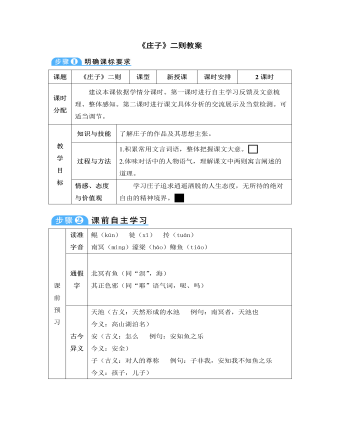
部编版语文八年级下册《庄子》二则教案
【再读课文,梳理结构】1. 文章标题为“北冥有鱼”,后来怎么又写鸟了?鸟是由鱼变化而来的。鲲的体形有几千里,变成鸟后,鸟的脊背不知有几千里长。说明庄子想象力丰富。2. 鸟为什么要迁徙到南冥?南冥是天人的大池,是鸟心目中的理想境地,是要追求一种精神的自由。3. 鲲鹏由北海飞到南海,需要借助什么条件?“海运则将徙于南冥”“抟扶摇而上者九万里,去以六月息者也”4. 句子赏析:“鹏之徙于南冥也,水击三千里,抟扶摇而上者九万里。”词句运用丰富的想象,奇特的夸张,描写了鲲鹏振翼拍水,盘旋飞向九万里高空的形象,这一形象能激发人的豪情壮志,具有强烈的艺术感染力。“击”“抟”等字传神、生动,让人产生丰富的想象和联想。
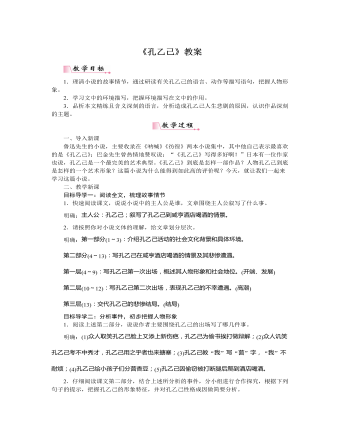
部编版语文九年级下册《孔乙己》教案
明确:(1)作者在前三段简要交代了故事发生的背景环境——咸亨酒店。咸亨酒店是一个人群集中之地,反映着形形色色的人,但重要的是长衫和短衣的区别,昭示着这是一个阶级分层的封建社会。而“掌柜是一副凶脸孔,主顾也没有好声气”也凸显出这个社会的薄凉。(2)“笑”是贯穿文中始末的一个关键词,首先从“只有孔乙己到店,才可以笑几声”的基调开始,孔乙己便已然注定是众人的笑料;果然,辩别盗窃,“引得众人都哄笑起来”;质疑他是读书人,“众人也都哄笑起来”;给孩子们吃茴香豆,“孩子都在笑声里走散了”;他最后一次出现,也是“在旁人的说笑声中,坐着用这手慢慢走去了”。然而,这个“笑”字在文中只是“轻松活泼”的假象,它是森然的,沉重的。“笑”里面表现的是人与人之间的冷漠,是世态人情的薄凉。而也是从这“笑”中,我们感受到了作者写在其中的怒,对社会于苦人的薄凉的控诉。
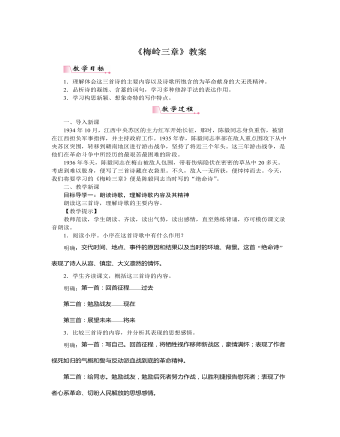
部编版语文九年级下册《梅岭三章》教案
【教学提示】教师范读,学生朗读、齐读,读出气势,读出感情,直至熟练背诵,亦可模仿课文录音朗读。1.阅读小序。小序在这首诗歌中有什么作用?明确:交代时间、地点、事件的原因和结果以及当时的环境、背景。这首“绝命诗”表现了诗人从容、镇定、大义凛然的情怀。2.学生齐读课文,概括这三首诗的内容。明确:第一首:回首征程——过去第二首:勉励战友——现在第三首:展望未来——将来3.比较三首诗的内容,并分析其表现的思想感情。明确:第一首:写自己。回首征程,将牺牲视作移师新战区,豪情满怀;表现了作者视死如归的气概和誓与反动派血战到底的革命精神。第二首:给同志。勉励战友,勉励后死者努力作战,以胜利捷报告慰死者;表现了作者心系革命、切盼人民解放的思想感情。第三首:望未来。展望未来,表现了作者乐观坚定的革命信念和甘为信仰牺牲的革命精神。
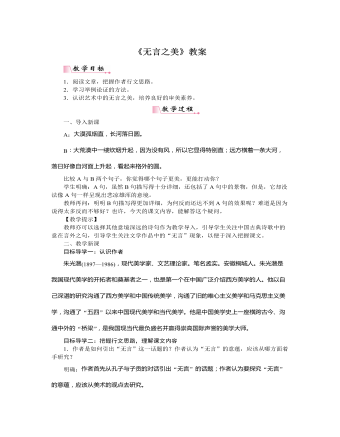
部编版语文九年级下册《无言之美》教案
目标导学三:深入理解,体会“无言之美”1.请你结合作者的任意一则论据,说说你对“无言之美”的感受。明确:正如作者探讨文学作品时的数个例子,诗歌本是极其简短的几句话,但是其包含的意境却是极其宽广的。如“大漠孤烟直,长河落日圆”,言语只有短短的十个字,但是读来却似看见大漠的宽阔宏伟之景,悲凉之意,予人以悲凉雄壮的美感。然而,作者要描写出这宽阔宏伟之景,悲凉之意,恐怕书万言都难以说尽,这不是意味着作者将它们寓于无言之中了吗?这就是古典文学中深蕴的无言之美。2.拓展延伸:品味下面一段话,说说你品味到“无言之美”的例子。拿美术来表现思想和情感,与其尽量流露,不如稍有含蓄;与其吐肚子把一切都说出来,不如留一大部分让欣赏者自己去领会。因为在欣赏者的头脑里所产生的印象和美感,有含蓄比较尽量流露的还要更加深刻。
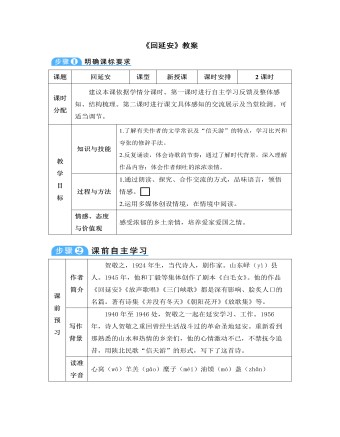
部编版语文八年级下册《回延安》教案
【初读课文,整体感知】1.诗歌共分为五小节,这五小节分别写了什么内容?第一小节:阔别十年重回延安;第二小节:追忆当年战斗生活;第三小节:亲人相见话延安;第四小节:喜看延安今繁华;第五小节:颂延安光辉历史。2.试想想诗人写作这首诗抒发思想情感的线索是什么?讨论、明确:全诗以诗人离别10年后重返延安的所见所闻所想为线索。【细读课文,仔细品味】1.作者在第一节中是怎样通过一系列动词表现情感的?“抓”“贴”等逼真的动作,表现了诗人回到延安时的激动情景。“双手搂定宝塔山”的“搂”字,写尽了作者对延安的怀念。“唱”“笑”“招”具有拟人的色彩,渲染了欢乐的气氛。最后一个“扑”字,强烈、准确地表达出作者的想念。2.第二节中,“二十里铺送过柳林铺迎,分别十年又回家中”在结构上有什么作用?


